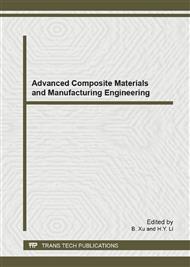p.40
p.44
p.49
p.53
p.57
p.62
p.66
p.71
p.75
Vibration Characteristics Analysis of Aeroengine Composite Blade
Abstract:
In order to validate the dynamic response and the dynamic stress distribution of the blade, EMA and FEM were performed to study the vibration characteristics. A non-contact laser scanning viberometer was used to measure the blade modal response. After the signal process of the response, the natural frequencies, mode shapes and their nodal lines can be obtained by the modal parameter identification method. And the blade modal damping ratio can be calculated from its frequency response function (FRF), which was obtained during the test, by the half-power method. Based on the test results, a simplified computational model was established by layup method, and after modification, the error of FEM results and EMA results was less than 5%. So the blade vibration characteristics and its finite element prediction model were obtained by the two methods combined, which would laid a foundation for the dynamic test and the vibration fatigue life prediction of the blade.
Info:
Periodical:
Pages:
57-61
Citation:
Online since:
October 2012
Authors:
Price:
Сopyright:
© 2012 Trans Tech Publications Ltd. All Rights Reserved
Share:
Citation:


